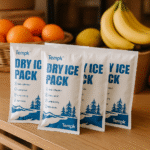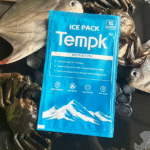Dry ice packs are a crucial part of temperature-sensitive shipping, helping to keep products like pharmaceuticals, food, and medical samples cool during transit. But how long do these ice packs last? In this guide, we’ll explore the factors that influence the lifespan of dry ice packs and provide tips for optimal use.
-
How long do dry ice packs last in shipping?
-
What factors affect the longevity of dry ice packs?
-
How can you optimize the use of dry ice for shipping?
-
Why are dry ice packs ideal for cold chain logistics?
How Long Do Dry Ice Packs Last?
Dry ice ice packs can last anywhere from 24 to 72 hours, depending on several factors like the size of the ice pack, insulation quality, and environmental conditions. The better the packaging and storage conditions, the longer the ice will remain effective.
Factors That Affect the Longevity of Dry Ice Packs
-
Size of Dry Ice Packs: Larger blocks of dry ice last longer than smaller pieces. The bigger the ice pack, the more cooling power it provides, extending the duration of its effectiveness.
-
Quality of Insulation: Packaging plays a significant role in the longevity of dry ice. Higher-quality insulation, such as polystyrene foam or cooler boxes, reduces heat transfer and keeps the dry ice colder for longer.
-
Environmental Temperature: Warmer environments cause dry ice to sublimate faster. The cooler the shipping environment, the longer the dry ice pack will last. For this reason, shipping in colder seasons or using refrigerated transport can extend its lifespan.
-
Type of Cargo: The nature of the goods being shipped also affects dry ice longevity. Products that are highly sensitive to temperature changes may require more dry ice or frequent replenishment during transit.
How Can You Optimize the Use of Dry Ice Packs?
To make sure your dry ice packs last longer and provide effective temperature control during shipping, follow these best practices.
1. Use Insulated Packaging
The quality of the packaging is one of the most critical factors in extending the life of dry ice. Thermal insulation minimizes the exchange of heat, preserving the cooling properties of dry ice. Use thick expanded polystyrene (EPS) or polyurethane foam containers to keep the dry ice cooler for longer.
2. Choose the Right Amount of Dry Ice
For longer shipping periods, consider using larger amounts of dry ice. 10-20 lbs of dry ice is ideal for longer shipments, while smaller packages can suffice for short transit times.
3. Limit Opening the Package
Opening the package releases cool air and exposes the dry ice to warmer air, which accelerates sublimation. To keep dry ice lasting longer, avoid opening the package until absolutely necessary. Ensure that the container is vented properly to allow for safe release of CO2 gases.
4. Monitor and Replace Dry Ice as Needed
If your shipment spans multiple days, check the dry ice levels and add more as needed. Some shipping solutions allow you to monitor the amount of dry ice left, so you can adjust accordingly.
| Factor | Impact on Dry Ice Duration | Best Practice |
|---|---|---|
| Size of Dry Ice Pack | Larger packs last longer | Use larger blocks for longer shipments |
| Insulation Quality | Better insulation slows sublimation | Opt for thicker, high-quality insulation |
| Environmental Temperature | Warmer temperatures accelerate sublimation | Ship in cooler seasons or use refrigerated transport |
| Amount of Dry Ice | More dry ice means longer cooling | Use appropriate amounts based on shipment duration |
Applications of Dry Ice Packs in Cold Chain Logistics
Dry ice ice packs are widely used across various industries to maintain the temperature of sensitive products during transport. Below are some key applications:
1. Pharmaceuticals and Biotech
For pharmaceuticals and biotech products like vaccines and medications, maintaining the right temperature is essential. Dry ice packs ensure these products remain at the required temperature range, preserving their efficacy during transport.
2. Food Industry
Shipping frozen foods, fresh meat, and seafood requires efficient temperature control. Dry ice packs are commonly used to maintain the cold chain, preventing spoilage and ensuring products arrive in optimal condition.
3. Flowers and Perishables
Dry ice packs are also used to keep cut flowers and plants fresh during shipping. By maintaining a cool environment, dry ice helps prevent wilting and damage during long-distance transport.
Best Practices for Using Dry Ice Packs in Shipping
-
Proper Packaging: Always use insulated, durable packaging that’s designed for dry ice. This will help preserve the cooling effect and keep your products safe during transit.
-
Pre-cool the Shipping Container: Before placing the dry ice and products inside, pre-cool the shipping container if possible. This ensures that the dry ice doesn’t have to work as hard to cool the contents.
-
Use Temperature Monitors: Utilize temperature sensors to track the temperature during shipment. This provides real-time data to ensure that the dry ice is functioning effectively and the product remains within the correct temperature range.
Real-World Example: A biotech company shipping temperature-sensitive research samples uses insulated boxes with dry ice ice packs. By monitoring the temperature and adjusting dry ice levels during transit, they can keep the samples viable for up to 72 hours.
2025 Trends in Dry Ice for Cold Chain Shipping
As the cold chain logistics industry evolves, new technologies are emerging to enhance the effectiveness of dry ice in shipping.
Recent Advancements
-
Advanced Insulation Materials: New, more efficient insulation materials are being developed to extend the life of dry ice during shipping, even in challenging conditions.
-
Eco-friendly Dry Ice Solutions: Innovations in sustainable dry ice production are gaining traction, aiming to reduce the environmental impact of shipping practices while maintaining temperature control.
-
Smart Shipping Solutions: Temperature-controlled packaging integrated with IoT (Internet of Things) technology is now available, providing real-time temperature monitoring and more accurate shipping predictions.
Market Insights
-
Increasing Demand for Temperature-Controlled Shipments: As the demand for pharmaceuticals and perishable goods grows, the use of dry ice for cold chain shipping is becoming more widespread.
-
Improved Efficiency in Shipping: The rise of more efficient dry ice packs and shipping solutions is helping businesses reduce costs while ensuring better protection for sensitive products.
Frequently Asked Questions
How long does dry ice last for shipping?
Dry ice can last anywhere between 24 to 72 hours, depending on factors like the amount of dry ice used, packaging, and shipping environment.
How much dry ice is needed for long shipments?
For shipments lasting more than 24 hours, you should consider using 10-20 lbs of dry ice, depending on the package size and insulation quality.
Can dry ice be used for pharmaceuticals?
Yes, dry ice is commonly used to maintain the required temperatures for pharmaceuticals, ensuring the products remain stable and effective during transit.
Summary and Recommendations
Dry ice packs are an effective and reliable solution for cold chain shipping, especially for temperature-sensitive products. By understanding the factors that influence dry ice longevity, you can optimize your shipping processes to ensure products are transported safely and efficiently.
Next Steps: Evaluate your cold chain needs, determine the appropriate amount of dry ice, and use high-quality insulation to ensure optimal performance during transit.
About Tempk
Tempk specializes in providing temperature-controlled packaging solutions, including dry ice packs. Our products are designed to ensure safe, efficient transport of temperature-sensitive goods.
Contact us today to learn more about how we can optimize your cold chain logistics!
























